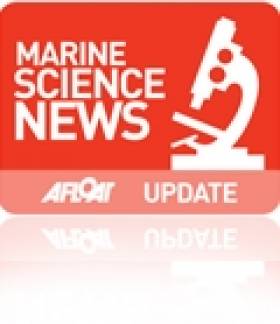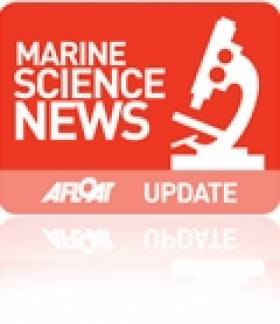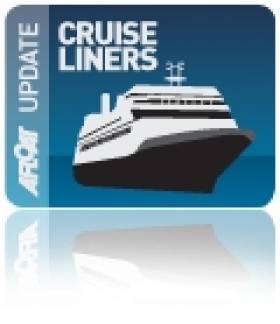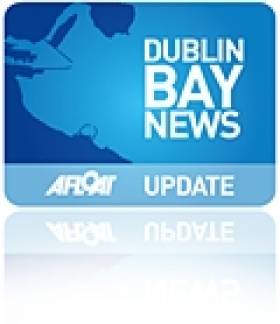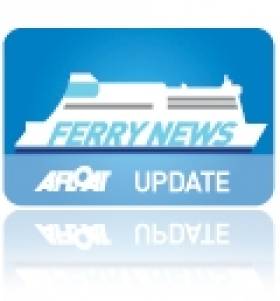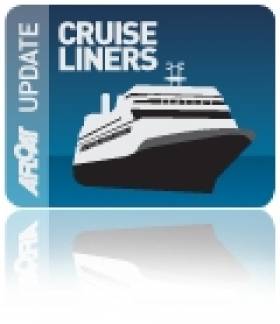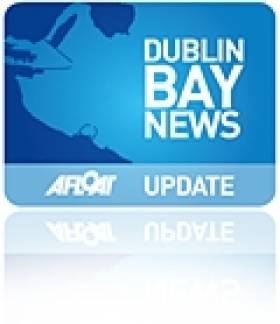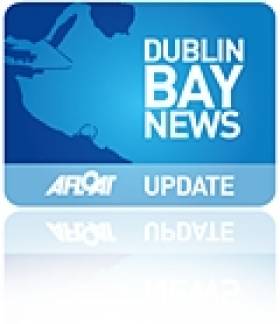Displaying items by tag: Dun Laoghaire Harbour
#MARINE RESEARCH YACHT– The 36m French marine biology research yacht Tara, skippered by Loic Valette, sailed under motor-power into Dun Laoghaire Harbour from Lorient this afternoon, writes Jehan Ashmore.
The two-master is operated by Tara Expeditions which is a non-profit organisation which aims to learn more about the impact of climate change on ecosystems. She has travelled extensively on expeditions to both poles and throughout the world and where the organsiation have collected samples and data to the scientific community.
The port of call is so that she can take part in the Dublin 'City of Science 2012' festival.
Tara will be moored alongside the harbour's East Pier during tomorrow and Thursday, where the public are invited on board to tour the vessel on a first come first served basis. Opening times on both days are between 1-7pm and taken in small groups, noting limited accessibility. Crew will provide guided tours of the class B aluminium built yacht once owned by Jean-Louis Etienne and Sir Peter Blake. For further details click HERE.
As previously reported, the Marine Institute's RV Celtic Explorer docked in Dublin Port today in advance of the ESOF 2012 conference which is the highlight of the year-long science festival. For information visit www.dublinscience2012.ie
French Scientific Schooner to Visit Dun Laoghaire Harbour
#MARINE SCIENCE TALLSHIP- As part of Dublin City of Science 2012, a 'Science in the City' festival (6-15 July) is to include the French scientific expedition schooner Tara, which is to receive a welcoming flotilla on her arrival to Dun Laoghaire Harbour on 10th July, writes Jehan Ashmore.
At only 36m long, the Tara is unique vessel in that she is used for scientific discovery and adventure purposes, as otherwise most such vessels are larger motorships. The schooner is run by the French based non-profit organisation Tara Expeditions that provides samples and data to the scientific community worldwide.
She has accomplished eight expeditions – to the Antarctica, Arctic, Greenland, Patagonia, southern Georgia and throughout the rest of the world. Before her scientific adventure role she was owned by Jean-Louis Etienne and Sir Peter Blake.
Tara Expeditions aim to learn more about the impact of climate change on ecosystems. One of the core objectives is to increase environmental awareness among the general public, and particularly young people through their Tara Junior outreach programme.
She is to be open to the public at her mooring at the harbour's East Pier where her crew will provide guided tours on the 11th and 12th June. Visits on a first come first served basis (between 11am-6pm) where 3 to 4 groups numbering between 8-12 people will be accommodated.
Cruiseship's Return Consolidates New Business
#CRUISE CALLER – The small expedition cruiseship Quest made a return port of call to Dun Laoghaire Harbour early this morning, having inaugurated the season last month, writes Jehan Ashmore.
The 50m long vessel operated by Noble Caledonia carries 52 passengers and a crew of 25 had sailed overnight from Holyhead. She departed the Anglesey port at 20.00hrs and she took a leisurely 10-hour passage to cross the 60 nautical mile Irish Sea route.
Her visit to Dun Laoghaire today will provide her passengers to visit Powerscourt and Mount Usher Gardens in Co. Wicklow as part of a Garden themed cruise throughout destinations in the UK and Ireland.
On this occasion she is taking the cruise in reverse direction having previously made a southbound circuit starting at Oban and ending in Poole.
Likewise to her call nearly three weeks ago, she is moored alongside Carlisle Pier, which is designated berth number two out of a total five berths that are used for commercial vessels.
New Moorings Plan for Dun Laoghaire's Coal Harbour
#BERTHS – Dun Laoghaire Harbour Company plans to double pleasure craft moorings at the Coal Harbour area of the east coast port by providing up to 150 public berths on floating pontoons.
The company sought expressions of interest earlier this month from a variety of parties including local clubs and businesses to develop and manage the project located in the inner harbour area near the fishing fleet berths at Trader's Wharf.
If the new pontoon facility goes ahead it will replace the existing 30 swinging and fore and aft moorings in the Coal harbour and a further 40 in the shallows on the inner West Pier.
Dun Laoghaire harbour on the south shore of Dublin Bay is Ireland's biggest boating centre. As well as four leading Irish yacht clubs the harbour houses the country's largest marina facility with an 850–berth capacity. The marina has berthage vacancies for the current season.
The facility plan comes under page 72 of the Dun Laoghaire Harbour Master plan that was published last year and aims to turn the harbour into an 'exciting marine leisure destination of international calibre'. An artist's impression of the new harbour is here.
The new pontoon is aimed at smaller boats and motor boats. It is also designed to make space for other craft when the numbers of moorings on the East bight area in the main harbour are reduced over time according to the Masterplan.
Other parts of the plan including attracting cruise–liner traffic into the harbour and a new sea water baths on the East Pier are already being implemented.
Consulting engineers have produced a preliminary layout (see above) providing a mix of berth sizes from 4.5 metre up to 7 metre berths.
Cruise Callers to Dun Laoghaire ‘Recalled’
#DUN LAOGHAIRE CRUISELINERS – The recent call of what is believed to be the world's smallest cruiseship the Quest (1991/1,180grt) to Dun Laoghaire Harbour as part of an initiative to develop this sector is by no means completely new to the harbour, writes Jehan Ashmore.
It was not until a decade ago that the last cruise callers were on the scene, albeit making infrequent visits and they also varied considerably in size. Among the callers was the famous 'Cunarder' Queen Elizabeth 2 or 'QE2', RCCL's Norway formerly French Line's France and Celebrity Cruise then brand new Constellation. Notably these large vessels all made anchorage calls in Dublin Bay.
Constellation made this call in 2002 as did the Sun Bay II which was also then recently launched into service and the cruiseships were making their debut season in European waters. They could not be so different, the 2,800 tonnes Sun Bay II with an 89 passenger capacity in complete contrast to the 90,000 tonnes Constellation with over 1,800 passengers.
The diminutive Sun Bay II was not too dissimilar to Noble Caledonia's Quest in terms of passenger capacity being slightly smaller with a capacity of 52. She was alongside Carlisle Pier where her guests were on a 9-night Garden themed cruise of UK and Ireland that included tours to Powerscourt and Mount Usher in Co. Wicklow.
On the call of Constellation she anchored relatively closer to the shore off Bulloch Harbour, compared to QE2 and Norway's calls and she presented an imposing and impressive sight.
In the case of the Norway, her passengers were ferried to the marina by unusually large tenders more akin to tank landing craft as they bow doors (click PHOTO). In fact they were so large that they could not be stowed on the lifeboat deck and instead located forward of the bridge where deck-mounted cranes were used for hoisting operations.
The practice of anchorage calls will continue as vessels of this size will remain too large to be accommodated in the harbour in the short term, though the Dun Laoghaire Harbour Company's 'masterplan' includes a proposed €18m new cruise terminal. They claim the terminal would be capable of handling the largest and most modern cruiseships in the world.
In the meantime the landing point for tenders to use a new tender dock facility was installed recently at the Traders Wharf, as distinct to the Carlisle Pier (site of proposed Diaspora Museum) where small to medium sized vessels are to berth.
A further three more calls are scheduled this season, including a return call next week of Quest and other vessels capable of carrying around 500 passengers. This figure is to rise considerably in May 2013, thanks mostly due in part to the massive Cunard Line flagship Queen Mary 2 (QM2). The 151,400 tonnes 'liner' can take over 2,600 passengers and 1,200 crew alone.
With the visit of QM2, this is to be her fist call to Dublin Bay, as she is still to be big even for Dublin Port to handle. Likewise the rivals across Dublin Bay in the Dublin Port Company are proposing as part of their masterplan to build a €30m dedicated cruise terminal. This facility would also be able to accommodate very large cruise callers.
It will be interesting to see how both completing ports progress and how they market themselves to the cruise sector industry, no doubt across the board. The giant ships look after large volumes which keep cruise prices down. As for the smaller boutique style of cruiseship operators, they can command higher prices by targeting the top end of the market and where they have higher-spending power at ports of call . The cruise industry overall is becoming increasingly more globalised where it was traditionally the preserve of the European and North American markets.
Arguably it is debatable if there should be two cruise terminals built as it reminiscent of the controversary during the '80's over the battle between which Dublin Bay port would be chosen for the site of a new single dedicated multi-user car-ferry terminal.
As it transpired the ferry service to Holyhead remains operating out of Dun Laoghaire Harbour, where a new terminal was built specifically to dock the revolutionary design of the HSS (High-speed Sea Service) fast craft catamaran car-ferry. Albeit in recent years the route's sailing frequency has reduced considerably. Under the last contract between Stena and the harbour company, this has led to considerably less revenue generated in harbour dues. The HSS Stena Explorer currently maintains only a single daily round-trip and only on a seasonal basis between April-September.
While at Dublin Port a multi-user ferry terminal was built but Stena Line did not immediately become part of the facility. It was not until 1995 that they set up an additional new service from Dublin Port to Holyhead. They use a second adjacent terminal that is currently served by two ferries on the company's second route to Wales.
Calling Cherbourg: All Things Nauting
#FERRY SAILS – Ferry passengers perhaps on a mini-wine break cruise between Rosslare-Cherbourg may be taking a detour to the Cherbourg Nauting Boat Show which is been held this weekend, writes Jehan Ashmore.
Both Celtic Link Ferries and Irish Ferries operate on the continental route to the man-made Norman port originally constructed by Napoleon. The present day bustling town-centre of Cherbourg-Octeville to give its full name is close to the large 1500-plus berth marina at the Port Chantereyne which is hosting the show.
Those attending can buy and sell new and second-hand boats and where there will be exhibitors attending the three-day show which started yesterday. Activities include scuba-diving, dry surf, stand-up-paddle and model-boats on a dedicated pool.
In addition there is a guided-tour on a racing-boat commented by its skipper Eric D'Hooghe from the Figaro Race. Also making an appearance is the French rower Rémy Alnet who will be there to talk about his trans-Atlantic races.
Also on a related note is the La Cité de la Mer which is a museum situated in the former trans-Atlantic liner passenger terminal used during the so called golden era. The history of these liners is recalled in the museum and of course includes the RMS Titanic and the French Line's famous France which as the Norway made a once off anchorage call outside Dun Laoghaire Harbour.
In addition there are displays of submarines including the decomissioned French Navy nuclear-powered submarine Le Redoutable which is located in an adjoining dry-dock.
- Ferry news
- Cherbourg Nauting
- Napoleon Port of Cherbourg
- Port de Cherbourg
- Cite de la Mer
- CherbourgOcteville
- RosslareCherbourg
- Port Chantereyne marina
- Celtic Liink Ferries
- Irish Ferries
- WineBreak Mini Cruises
- Scubadiving
- DrySurfing
- standup paddle
- SUP
- ModelBoats
- New Boats
- SecondHand Boats
- TransAtlantic Liners
- Le Redoutable submarine
- French Navy
- RMS Titanic
- French Line's France
- Cruiseship Norway
- Dun Laoghaire Harbour
- Dun Laoghaire Harbour cruise liner calls
- Dun Laoghaire Harbour Norway anchorage call
- Cruiseships
- Cruiseliners
- Figaro Race
- Eric D'Hooghe
- French rower Remy Alnet
- Remy Alnet
- La Cité de la Mer
Cruise Call Opens New Opportunities for Dun Laoghaire Harbour
#CRUISE CALLS - The docking of the Quest in Dun Laoghaire Harbour this morning marks the first phase of cruise calls this summer as part of a new development to attract cruiseships, writes Jehan Ashmore.
The opening of the cruise sector business which formed part of the Dun Laoghaire Harbour Company's Masterplan is seen as a significant boost to the local economy considering the declining operations of the HSS fast-ferry service in recent years.
The Quest which is operated by Noble Caledonia is on a 9-night 'Garden' Cruise of the UK and Ireland, where prices started from £3,295. She berthed at the Carlisle Pier where for many generations passengers boarded the mail-boats followed by the conventional ferry to Holyhead which last left the route in 1996.
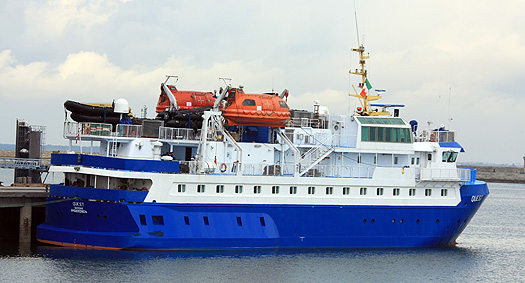
Quest along side in Dun Laoghaire. She carries 50 passengers
At just under 50m long the Quest carries only 50 passengers though this number is set to increase when a further four cruise calls are scheduled this season with larger vessels capable of carrying around 500 passengers.
#CRUISELINERS – The Quest (1992/1,180grt) an ice-strengthened expedition cruiseship, will have the distinction of being the first cruise caller to Dun Laoghaire Harbour in many years. The cruise call next week (24th April) will mark a new era in attracting the cruise sector as part of the harbour's masterplan launched last year, writes Jehan Ashmore.
The Quest will have a German clientele of around 50 passengers, though other larger capacity vessels are scheduled for the summer in this first phase of cruise callers. The cruise sector season is seen to be a significant economic boost to the local economy considering the reduced ferry side of the harbour business in recent years.
Passengers on the Noble Caledonia operated vessel are to take a 9-night 'Garden' Cruise with prices starting from £3,295. She is to set sail from Oban Scotland, then to Ireland, Wales, Cornwall, the Isles of Scilly and Channel Islands.
On her Dun Laoghaire call passengers will head for Powerscourt and nearby Mount Usher gardens in Co. Wicklow. On the second Irish port of call to Waterford as previously reported, they will visit the privately owned Mount Congreve Gardens on the banks of the River Suir.
Notably scheduled in for next year's season is the 'flagship' of the Cunard Line fleet, the 2,620 passenger liner Queen Mary 2, all of 151,400 gross tonnes. She is to make an anchorage call in May 2013, according to Captain Frank Allan, Dun Laoghaire Harbourmaster.
As part of the programme to attract and develop Dun Laoghaire as a cruise call port of call, a new tender docking facility was recently completed. The facility is designed to cater for large cruiseships using the harbour as it will cater for easier access by boats tendering passengers to vessels such as Queen Mary 2 during anchorage calls out in Dublin Bay.
The new tender facility will also benefit the public as the facility can be used for training purposes and for the operation of boat tours around Dublin Bay and trips out to Dalkey Island.
- Dun Laoghaire Harbour
- Cruise Liners
- Irish cruise calls
- Noble Caledonia
- MVQuest
- Cunard Line
- Queen Mary 2
- QM2
- Dun Laoghaire Harbour Company
- Dublin Bay
- Dublin Bay anchorage cruise calls
- Dalkey Island
- Powerscourt Gardens
- Mount Congreve Gardens Waterford
- River Suir
- Dun Laoghaire Harbour Masterplan
- Dublin Bay News
Councillors to Consider New Dun Laoghaire Harbour Sea Baths
Funding for a new sea baths located inside Dun Laoghaire harbour on Dublin Bay will be considered tomorrow by Dun Laoghaire Rathdown County Councillors. The new sea baths proposal is part of Dun Laoghaire harbour company's master plan launched last June that envisages the creation of up to 1000 jobs but has drawn the ire of local yacht clubs. The proposed position for the new sea baths is on the East pier directly in front of the National Yacht Club.
The councillors are being asked to allocate €1.5 million for the new facility in spite of the fact the victorian Dun Laoghaire baths remains derelict after over 20 separate council plans have failed to rejuvinate it to date. In the past week the derelict site has had a makeover thanks to a Dulux 'Lets Colour Project'.
An artists impression produced last November shows some of the proposed changes for the harbour.

An artist's impression of the new Sea baths on the East Pier in Dun Laoghaire. Councillors will vote on a €1.5m funding allocation tomorrow
"The Masterplan will position Dun Laoghaire Harbour as a marine, leisure and tourism destination of international calibre", Gerry Dunne, Chief Executive Officer, Dun Laoghaire Harbour Company said last June.
Gerry Dunne will address the Councillors tomorrow night with oultine plans for the baths and the harbour masterplan.
"We need to spend an average of €5m a year on maintaining and developing the Harbour infrastructure. The Masterplan will involve investment of more than €230m, over the next 10-15 years and will result in 1000 sustainable jobs in areas such as tourism, marine service companies, select retail, and food and beverage." the CEO said.
Easter Sunday Marks Rebirth of Mariners Maritime Museum
#MARTIME MUSEUM AT EASTER - Earlier this week Dun Laoghaire's maritime museum re-opened its doors to the public after a €4m renovation project was carried out on the apt venue of the former Mariners Church, which incidentally closed on this Easter Day forty years ago, writes Jehan Ashmore.
With a new lease of life the extensively renovated and upgraded museum can look forward to a future. Visitors enter the museum at a new entrance, where in the reception foyer there is a souvenir shop, beyond that in the main body or nave are exhibits displayed, each telling a story and for children there is a Knott Station. To view the initial exhibits on display, click HERE.
In addition there is new facility in the form of a café, which was much needed and where two new stained -glass windows by Peadar Lamb feature, they were sponsored by the Dun Laoghaire Harbour Company. As for the original stained-class windows they were restored to their full glory.
The renovation began in 2006 and was funded by the Government which led to a three-phrased project that involved work carried out from the re-roofing right down to the floorboards. Walls were re-plastered, electric systems modernised and wheel chair-lift and ramps installed.
Work also took place to clean the exterior of the stone-cut granite building hewn from Dalkey Quarry and which led to the consecration of the Kingstown Episcopalian Mariners Church in 1843.
After many generations of mariners and their families, parish numbers dwindled and its use as place worship ended on Easter Sunday 1972. The Maritime Institute of Ireland which runs the museum relocated two years later having had a smaller museum sited along the town's harbour waterfront.
For the next three decades the museum which has attracted locals and visitors from home and overseas, eventually had to close due to deteriorating conditions of an aging building.
Now that the museum is up and running, the M.I.I. which is staffed by volunteers has in recent years also had the support of a FAS scheme of workers, which according to the institute have been invaluable.
The museum is open 11am to 5pm Tuesday to Sunday and every Bank Holiday, for further information visit: www.mariner.ie


























